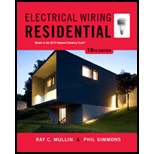
Electrical Wiring Residential
18th Edition
ISBN: 9781285170954
Author: Ray C. Mullin, Phil Simmons
Publisher: Cengage Learning
expand_more
expand_more
format_list_bulleted
Concept explainers
Question
Chapter 32, Problem 1R
To determine
Find the basic safety rule when working with electricity.
Expert Solution & Answer
Answer to Problem 1R
The basic safety rule when working with electricity is to turn off the power.
Explanation of Solution
Discussion:
The basic safety rules to be followed when working with electricity are listed below:
- When hooking up with the standby systems, always turn OFF the power. Do not work with “live” equipment.
- Installation instructions provided by the equipment manufacturers should be read and followed carefully to operate equipment.
- Do not work with wet hands.
- Do not stand on water when working with electricity.
- After qualifying from the electrical testing laboratories, equipment such as panelboards, generators, transfer switches, and power inlets should be installed.
- Do not touch the bare wires.
Conclusion:
Thus, the basic safety rule when working with electricity is to turn off the power.
Want to see more full solutions like this?
Subscribe now to access step-by-step solutions to millions of textbook problems written by subject matter experts!
Students have asked these similar questions
Don't use ai to answer I will report you answer please
Draw the digital modulation outputs, ASK (Amplitude Shift Keying), FSK (Frequency Shift
Keying) and PSK (Phase Shift Keying). For baseband and carrier frequency as shown
BASESAND
0
CARRIER
101
wwwwwwwwwwwww
Don't use ai to answer I will report you answer
Chapter 32 Solutions
Electrical Wiring Residential
Ch. 32 - Prob. 1RCh. 32 - Where would the logical location be for running a...Ch. 32 - Prob. 3RCh. 32 - Prob. 4RCh. 32 - Prob. 5RCh. 32 - Is it permitted to ground the neutral conductor of...Ch. 32 - Briefly explain the function of a transfer switch....Ch. 32 - When a transfer switch transfers to standby power,...Ch. 32 - A typical transfer switch for residential...Ch. 32 - Prob. 10R
Knowledge Booster
Learn more about
Need a deep-dive on the concept behind this application? Look no further. Learn more about this topic, electrical-engineering and related others by exploring similar questions and additional content below.Similar questions
- please explain step by step how ti solve these problems and include good explanations. I am most confused with graphing. Thank you, I will give positive feedback. The rest of the questions to this problem are submitted as a new questions due to the multiple part limitarrow_forwardDon't use ai to answer I will report you answerarrow_forwardThis is the last two questions of a previous question I just sent. Please show step by step with clear explanations as to what to do for these questions. I am very confused. Thank you, I will give positive feedbackarrow_forward
arrow_back_ios
SEE MORE QUESTIONS
arrow_forward_ios
Recommended textbooks for you
 EBK ELECTRICAL WIRING RESIDENTIALElectrical EngineeringISBN:9781337516549Author:SimmonsPublisher:CENGAGE LEARNING - CONSIGNMENT
EBK ELECTRICAL WIRING RESIDENTIALElectrical EngineeringISBN:9781337516549Author:SimmonsPublisher:CENGAGE LEARNING - CONSIGNMENT

EBK ELECTRICAL WIRING RESIDENTIAL
Electrical Engineering
ISBN:9781337516549
Author:Simmons
Publisher:CENGAGE LEARNING - CONSIGNMENT